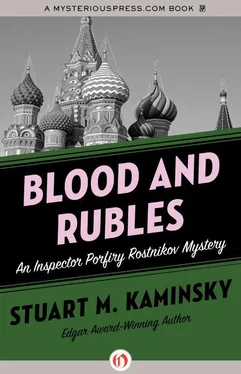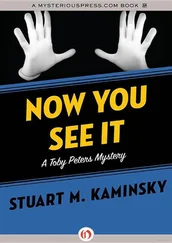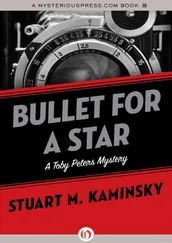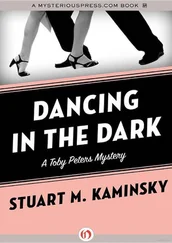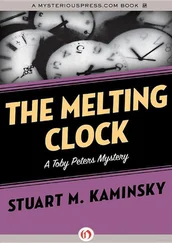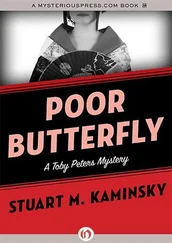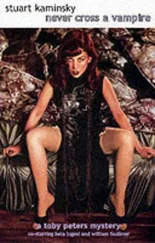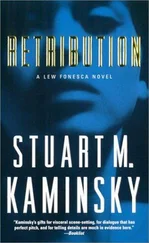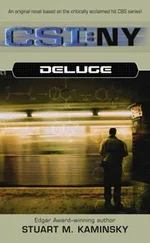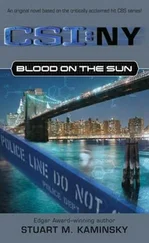Stuart Kaminsky - Blood and Rubles
Здесь есть возможность читать онлайн «Stuart Kaminsky - Blood and Rubles» весь текст электронной книги совершенно бесплатно (целиком полную версию без сокращений). В некоторых случаях можно слушать аудио, скачать через торрент в формате fb2 и присутствует краткое содержание. Год выпуска: 2012, Жанр: Полицейский детектив, на английском языке. Описание произведения, (предисловие) а так же отзывы посетителей доступны на портале библиотеки ЛибКат.
- Название:Blood and Rubles
- Автор:
- Жанр:
- Год:2012
- ISBN:нет данных
- Рейтинг книги:3 / 5. Голосов: 1
-
Избранное:Добавить в избранное
- Отзывы:
-
Ваша оценка:
- 60
- 1
- 2
- 3
- 4
- 5
Blood and Rubles: краткое содержание, описание и аннотация
Предлагаем к чтению аннотацию, описание, краткое содержание или предисловие (зависит от того, что написал сам автор книги «Blood and Rubles»). Если вы не нашли необходимую информацию о книге — напишите в комментариях, мы постараемся отыскать её.
Blood and Rubles — читать онлайн бесплатно полную книгу (весь текст) целиком
Ниже представлен текст книги, разбитый по страницам. Система сохранения места последней прочитанной страницы, позволяет с удобством читать онлайн бесплатно книгу «Blood and Rubles», без необходимости каждый раз заново искать на чём Вы остановились. Поставьте закладку, и сможете в любой момент перейти на страницу, на которой закончили чтение.
Интервал:
Закладка:
For more than four years Mathilde Verson, who had made her primary living as a prostitute, met Karpo in her room each week for an hour, for which he dutifully paid in clean bills laid neatly on her dresser. But gradually, somehow, the relationship changed. The ghost of a man who showed no emotion had been a challenge to her. She had tried to bring him out, had started to understand him. They had become friends and then real lovers, and no more money was exchanged. Mathilde had been the more present of the two, for Karpo had spent a lifetime withholding himself.
It was three bullets from the weapon near the tattooed man that had killed Mathilde.
Karpo’s hands moved slowly, his eyes stayed fixed. He had lost all meaning in his life. He had devoted himself to Communism and its eventual triumph. Karpo knew that there were corrupt leaders, that some, such as Brezhnev, might even have been both corrupt and stupid, but since the day he had been taken by his father to a party rally as a small boy, he had been won over to the cause. So, with the help of his steelworker father’s connections, he joined the police force as soon as he was old enough. Karpo’s mission was to let no crime against the state or its members go unpunished. He had put in sixteen-hour days and rarely took a day off. He lived alone in a small room, no larger than a monk’s chambers, where he slept on a bed in the corner. The rest of his meager furnishings consisted of two straight-backed wooden chairs, a desk, and a bookcase, which ran along one wall up to the ceiling. The only author represented in the several hundred identical black books was Emil Karpo. These books held his notes on all of his cases, with a special section for those that had not yet been solved. It was the unsolved cases that had occupied Karpo’s attention most of the time he spent in the apartment.
All of his clothing, and there wasn’t much of it, had been black until Mathilde had bought him a tie, a blue French tie with a small flower in the middle. Karpo had worn the tie twice before. He was wearing it today.
The Soviet Union had collapsed. Communism had almost disappeared. Crime, which once could be contained within the pages of his neatly kept notes, was now overwhelming. He would need a library the size of a football field to keep track of the anarchy that had clutched Moscow. Karpo had lost his mother when he was born. He had no sisters or brothers, aunts or uncles. His father had died four years ago, and now Mathilde. What had attracted her, she who was so full of life, so willing to laugh, so beautiful, to the dour, pale, humorless man Karpo saw in the mirror? That was the question he had asked both her and himself ever since they had been drawn together. And now she was gone.
“Well?” Paulinin prompted after a fruitless search for something among the mountain of piled-up books and the jars containing specimens of human organs, appendages, and even a man’s head. There were items of clothing on a rack in a corner, arranged in no particular way. Knives, wrenches, a hammer, saws, a pair of false teeth, plaster casts of footprints and handprints littered a table that ran the length of one wall. The other tables were similarly cluttered with boxes, large and small, and various objects including the metal handrail from a Moscow city bus stained with blood.
“Well?” Paulinin repeated, folding his hands for an instant on a mass of reports and papers on his desk and then rubbing his palms together.
Emil Karpo’s opinion of him was the only one Paulinin valued. This little man saw no one socially, lived alone, and slept at his desk as often as he went back to his apartment, which was in as much disarray as his office. He cared little who ran the government. Paulinin cared nothing about politics, which was one of the reasons he worked alone in a converted storeroom and was given almost no funding.
No one, however, ever considered getting rid of the nearly mad man in the blue smock, for it was generally acknowledged that Paulinin was an encyclopedia and a near-genius at examining forensic evidence.
“I have a surprise,” Paulinin said, trying to pry his visitor’s eyes from the photographs. Karpo was always quiet and correct, always spoke little, but today was different-today he was nearly a robot.
The police inspector continued to look at the photographs slowly, carefully. Finally he looked up, and Paulinin handed him a two-cup beaker of tea. Karpo took it and drank some of the brown, tepid fluid. It tasted of something sharp and bitter, the residue of some experiment that Paulinin had failed to remove completely from the beaker before brewing his tea.
“What do you make of it?” Paulinin asked, taking a sip of his own tea from a black cup on which was written in English PENSACOLA EYE AND EAR CLINIC.
Karpo looked down again at the photographs of the man who had killed Mathilde. The man was literally covered with tattoos-head, neck, arms, fingers, back, front, legs and toes, even his penis. The tattoos were colorful, vivid, and extremely well done. The subjects seemed random. On his right forearm a series of church domes, on his chest just below the collarbone a fiery eight-pointed star. The tattoo on his back depicted a rearing horse mounted by a man with a death’s-head, who in turn held a bearded man by the hair and appeared to be about to behead him.
Karpo turned to the photos of the nude body of the man who had died in the street. He, too, was covered in tattoos.
“Prison tattoos,” said Karpo.
“And?” Paulinin prompted.
Karpo knew a little about prison tattoos. He knew that professional criminals spent much of their time inflicting themselves with the tattoos when they were in prison, giving themselves some distinction from the other prisoners.
“Your tattooed men carried no wallets, no identification. There was a rubber band in the pocket of the bald one, a thick one. I would guess he was carrying a great deal of money and that it was taken from him before the police arrived. More likely, it was taken by the first officer at the scene.”
Karpo said nothing. He took out his notebook and began to write.
“All but one of your dead men’s tattoos are in code. This corpse,” he said, pointing to the bald man, “had been a pakhan, a prison boss, a member of the vory v zakone. The eight-pointed star makes that clear.”
“The eight church domes?” Paulinin asked.
“Each dome represents a completed sentence.”
“Good, good,” said Paulinin, gulping down his tea. “You paused at the death’s-head. A creature from medieval folk tales told by the Bogatyrs, a violent, crusading breed. It indicates that our corpse was a murderer. No drug tattoos. None that look forced on him by other inmates to mark him for crimes such as heroin addiction, crimes against children, submission. Your man has no facial tattoos and no sign that he ever had one and had it removed. In fact, he had no tattoos removed and has continued to shave his head prison-style. He was proud of his record.”
“And?”
Paulinin put his cup down. “His name is Mikhail Sivak. He was last imprisoned in Correctional Labor Colony Nineteen, maximum security, just outside of Perm. Your people will discover all this through his fingerprints perhaps, but it will take them days, perhaps a week or more if they even bother.”
Paulinin shook his head fiercely. His hair bounced.
“The newest tattoos on Mikhail Sivak are definitely in the style of Correctional Labor Colony Nineteen. I have seen them before. As for knowing his name, did you notice that his eyes are open in all the photographs?”
Karpo nodded.
“Those dolts at the hospital couldn’t tell you his name, though it was written right on him.”
“In prison code?” Karpo guessed.
Читать дальшеИнтервал:
Закладка:
Похожие книги на «Blood and Rubles»
Представляем Вашему вниманию похожие книги на «Blood and Rubles» списком для выбора. Мы отобрали схожую по названию и смыслу литературу в надежде предоставить читателям больше вариантов отыскать новые, интересные, ещё непрочитанные произведения.
Обсуждение, отзывы о книге «Blood and Rubles» и просто собственные мнения читателей. Оставьте ваши комментарии, напишите, что Вы думаете о произведении, его смысле или главных героях. Укажите что конкретно понравилось, а что нет, и почему Вы так считаете.
